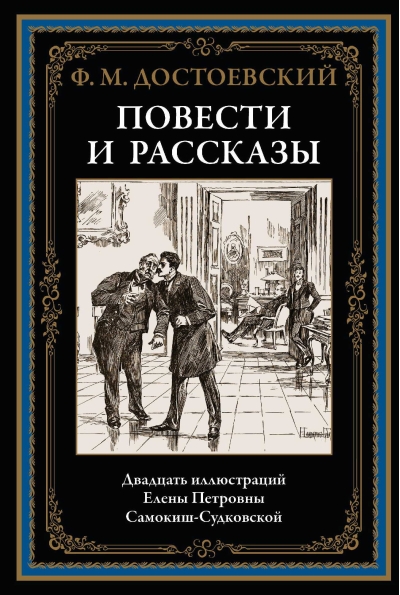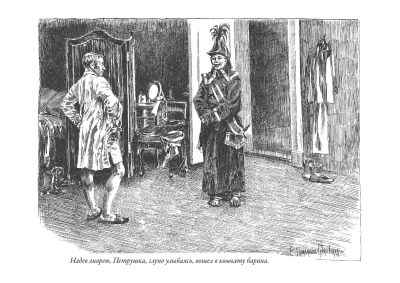Stories and tales
14.99 €
The only thing available 3
The collection includes seven novels by the world-famous Russian classicist F. M. Dostoevsky: "Dvoinik", "Mr. Proharchin", "Crawlers", "Another Man's Wife and Husband Under the Bed", "The Little Hero", "The Crocodile", and "The Village of Stepanchikovo and Its Inhabitants". At the end of the edition is an article about the life and work of Elena Petrovna Samokish-Sudkovskaya, whose drawings decorate this book, as well as her illustrations of other works by Dostoevsky, which are not included in this collection.
The novels and stories included in the collection were written by Dostoevsky between 1846 and 1864. In them Fyodor Mikhailovich develops the theme of "little people", so important for his work. Constrained life circumstances sometimes fatally affect the psyche of his characters, often pushing them to almost deviant behavior. Fearing an unpredictable future, the half-impoverished official Prokharchin saves money in a mattress, on which he ends his days. The consciousness of the hero of the story "The Double" bifurcates, creating his own phantom personality. In the story "The Village of Stepanchikovo and its Inhabitants," the despot Foma Fom Fomich compensates for his inferiority by terrorizing those around him. In "Another Man's Wife..." an anecdotal situation turns into a tragicomedy. Social humiliation sometimes pushes Dostoevsky's characters to try on the guises of jesters; these masks allow them to hide their own tears and heartache. Dostoevsky's humor is often the humor of tragedy, in which laughter struggles with tears against a background of bitter irony and sarcasm. The works of the collection are decorated with drawings by Elena Petrovna Samokish-Sudkovskaya. These and her other illustrations of the writer's works were published in 1895 in a separate album "The Humor of F. M. Dostoevsky". This album served as a free supplement to the magazine "Oskolki". The future artist was born in February 1862 in the family of a hereditary military engineer. She studied at the famous Pavlovsk Women's Institute and at the Helsingforska Art School at the famous painter Vasily Petrovich Vereshchagin. From 1882 to 1890 Elena Petrovna lived in Paris, studying in the atelier of Jules Bastien-Lepage. Her passion for painting brought her together with her future husband, the talented marinist Rufim Gavrilovich Sudkovsky. Unfortunately, just two years after the wedding Rufim Gavrilovicha brought to the grave typhus. Elena Petrovna grieved terribly. A few years later in St. Petersburg, she met her second future husband - a master of battle painting, Academician Nikolai Semenovich Samokish. At this time, Elena Petrovna was fond of Art Nouveau. She became widely known as an illustrator of children's books and works of the classics. Many people remember her drawings for "Eugene Onegin". Her illustrations for "The Humpbacked Horse" became widely known. The couple worked together on the drawings for "Dead Souls". The revolution of 1917 separated them on different sides of the barricades. Nikolai Semyonovich created his own art studio in Simferopol, and his wife moved to Paris, dear to her heart, lost among many other Russian emigrants.
The novels and stories included in the collection were written by Dostoevsky between 1846 and 1864. In them Fyodor Mikhailovich develops the theme of "little people", so important for his work. Constrained life circumstances sometimes fatally affect the psyche of his characters, often pushing them to almost deviant behavior. Fearing an unpredictable future, the half-impoverished official Prokharchin saves money in a mattress, on which he ends his days. The consciousness of the hero of the story "The Double" bifurcates, creating his own phantom personality. In the story "The Village of Stepanchikovo and its Inhabitants," the despot Foma Fom Fomich compensates for his inferiority by terrorizing those around him. In "Another Man's Wife..." an anecdotal situation turns into a tragicomedy. Social humiliation sometimes pushes Dostoevsky's characters to try on the guises of jesters; these masks allow them to hide their own tears and heartache. Dostoevsky's humor is often the humor of tragedy, in which laughter struggles with tears against a background of bitter irony and sarcasm. The works of the collection are decorated with drawings by Elena Petrovna Samokish-Sudkovskaya. These and her other illustrations of the writer's works were published in 1895 in a separate album "The Humor of F. M. Dostoevsky". This album served as a free supplement to the magazine "Oskolki". The future artist was born in February 1862 in the family of a hereditary military engineer. She studied at the famous Pavlovsk Women's Institute and at the Helsingforska Art School at the famous painter Vasily Petrovich Vereshchagin. From 1882 to 1890 Elena Petrovna lived in Paris, studying in the atelier of Jules Bastien-Lepage. Her passion for painting brought her together with her future husband, the talented marinist Rufim Gavrilovich Sudkovsky. Unfortunately, just two years after the wedding Rufim Gavrilovicha brought to the grave typhus. Elena Petrovna grieved terribly. A few years later in St. Petersburg, she met her second future husband - a master of battle painting, Academician Nikolai Semenovich Samokish. At this time, Elena Petrovna was fond of Art Nouveau. She became widely known as an illustrator of children's books and works of the classics. Many people remember her drawings for "Eugene Onegin". Her illustrations for "The Humpbacked Horse" became widely known. The couple worked together on the drawings for "Dead Souls". The revolution of 1917 separated them on different sides of the barricades. Nikolai Semyonovich created his own art studio in Simferopol, and his wife moved to Paris, dear to her heart, lost among many other Russian emigrants.
See also:
- All books by the publisher
- All books by the author
- All books in the series Library of World Literature



















































